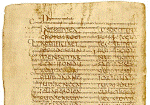The Recovery of Gaius'
Institutes
The complete work was
unknown except for excerpts in Justinian's Digest,
until in
1816,
B.G.
Niebuhr discovered
a manuscript in the Cathedral Chapter
Library of Verona, in
which some of the works of Saint Jerome were written
on top of an earlier text,
which proved to be the lost work of Gaius. The greater part of the
palimpsest has been deciphered, and
the text is now fairly complete. More recently, two sets of
papyrus fragments have
been found.
 The
discovery of Gaius' work has thrown light on portions of the history
of Roman law which had previously been obscure. Much of the historical
information given by Gaius is absent in the compilations of Justinian, and, in
particular, Justinian's jurists did not put Gaius' account of the ancient forms of procedure in actions
in the Digest. In these procedure
forms can be traced the "survivals" from the most primitive times, which provide comparative law with valuable illustrations,
and which may explain the
strange forms of legal procedure found in other early systems.
The
discovery of Gaius' work has thrown light on portions of the history
of Roman law which had previously been obscure. Much of the historical
information given by Gaius is absent in the compilations of Justinian, and, in
particular, Justinian's jurists did not put Gaius' account of the ancient forms of procedure in actions
in the Digest. In these procedure
forms can be traced the "survivals" from the most primitive times, which provide comparative law with valuable illustrations,
and which may explain the
strange forms of legal procedure found in other early systems.
There are several editions of the
Institutes, beginning with the
editio princeps of
I.F.L. Göschen (Berlin, 1820). The author of the 1911
Encyclopaedia Britannica
recommends the English edition of Edward Poste published in 1885,which includes
an English translation and copious commentary; more recent editions include E.
Seckel-B. Keubler (8th edition; Leipzig, 1939), and Francis de Zulueta, with an
English translation and commentary (2 volumes; Oxford, 1946).
Adapted from Wikipedia, the free encyclopedia
 The
discovery of Gaius' work has thrown light on portions of the history
of Roman law which had previously been obscure. Much of the historical
information given by Gaius is absent in the compilations of Justinian, and, in
particular, Justinian's jurists did not put Gaius' account of the ancient forms of procedure in actions
in the Digest. In these procedure
forms can be traced the "survivals" from the most primitive times, which provide comparative law with valuable illustrations,
and which may explain the
strange forms of legal procedure found in other early systems.
The
discovery of Gaius' work has thrown light on portions of the history
of Roman law which had previously been obscure. Much of the historical
information given by Gaius is absent in the compilations of Justinian, and, in
particular, Justinian's jurists did not put Gaius' account of the ancient forms of procedure in actions
in the Digest. In these procedure
forms can be traced the "survivals" from the most primitive times, which provide comparative law with valuable illustrations,
and which may explain the
strange forms of legal procedure found in other early systems.